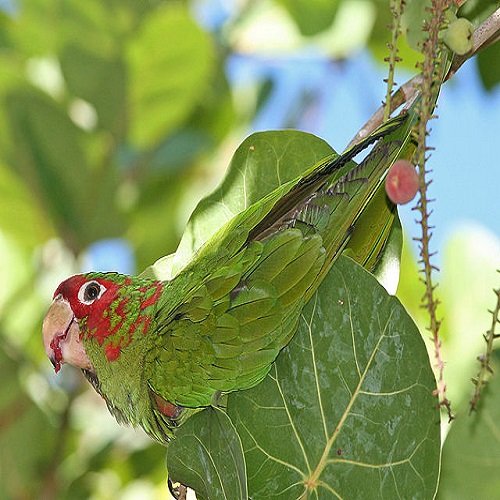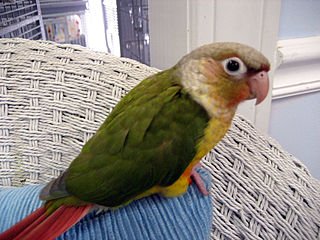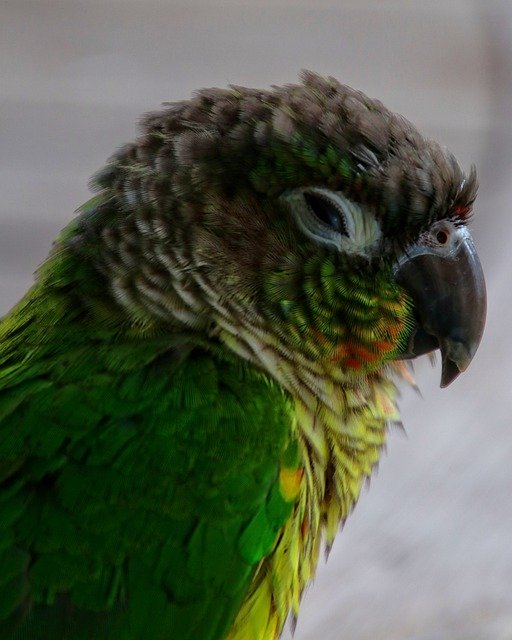The Mitred Conure (Psittacara mitratus) is, excuse the pun, a chirpy bird. Quick, snappy, and full of energy, this parakeet lookalike is not for the fainthearted. Being naturally curious and quick to learn, the Mitred Conure is the perfect bird for the experienced bird owner.
Are Mitred Conure Loud!?
Its exuberant green plumage with smatterings of red is the first thing you’ll notice about the Mitred Conure. The second thing you’ll notice is its tendency towards loud vocalizations whether provoked or not. In fact, the Mitred Conure is regularly used as a ‘watch bird’ – a bird that raises alarm upon seeing a stranger or noticing a disturbance.
It’s easy to fall in love with the playful and headstrong nature of this bird, especially since its long lifespan gives you time to get to know it. However, it’s not always easy to take care of due to its social needs.
It’s essential that you understand the many aspects and intricacies of the Mitred Conure before you decide to buy one. It’s also a remarkably interesting bird that’s well worth learning about. Here’s a full rundown on the remarkable Mitred Conure.
Mitred Conure Size and Colors
The Mitred Conure is a medium to small-sized long-tailed bird with a striking light green plumage. Red patches and stripes can also appear on the Mitred Conure’s body, especially to the forefront of its head and on the bend of its wings. However, these darker marks will only appear in the later years of the bird’s life, taking up to 8 or 10 years to form.
The Mitred Conure’s beak and feet are horn colored. A noticeable distinction is the thin white rings around their eyes.
The average length of a Mitred Conure is 13-15 in (33-38.1 cm) and they weigh-in at just about 7 oz (198 g).
There are few observable distinctions between male and female Mitred Conures. In fact, it can be next to impossible for the untrained eye to observe any differences at all. A professional vet must be consulted of the Mitred Conure is showing any symptoms of these diseases.
Some similar species to the Mitred Conure are he Cherry-headed / Cherry-head or Red-masked Conure (Aratinga erythrogenys.)
Mitred Conure Natural habitat
The Mitred Conure’s natural home is found in the deciduous and humid forests of South America. The Mitred Conure favors countries that the Andes Mountain range runs through such as Argentina, Bolivia, or north-western Peru. Here, the Mitred Conure can be found in humid, deciduous forests that lie 3,000 to 11,000 feet above sea level. The Mitred Conure has also been observed in woodland habitats but to a lesser extent.
The Mitred Conure was also introduced to the US states of Florida, California, and Hawaii with prosperous results for breeding and survival. However, the Mitred Conure posed a threat to local crops and was often credited with damages or disturbances to the livelihood of local farmers.
This result could’ve been predicted as the native habitat of the Mitred Conure is replete in suitable food sources. Due to this relative abundance in natural food sources and favorable climate, the Mitred Conure never had any need to migrate. Despite the problems, the Mitre Conure population continues to grow in the US.
Mitred Conure Behavior
The Mitred Conure is a fiery little bird with a strong personality and will to learn. In nature, they tend to form flocks of up to 100 or more, leading to a very sociable and interactive personality. Exceptionally, Mitred Conures have even been observed to gather in groups of 2,000 during the breeding season (late November, early December).
This means that they can talk and make noises for hours upon end without any discernible reason. However, noise-levels will increase if they are frustrated or alarmed. The Mitred Conure even loves to play and muck about, often pulling tricks or performing silly dances to entertain their owners or each other.
However, like most birds, the Mitred Conure can have its moody moments. They are known to nip and peck at their owners or each other if frustrated or simply in a bad mood. These downtimes never last long, especially if the bird is well cared for.
Mitred Conure Care
Due to its natural active and energetic nature, a rather large cage with plenty of distractions is suitable for the Mitred Conure. Dimensions around 24x24x36 feet are perfect giving the curious bird plenty of room to move around and explore. 2-3 perches are in order for necessary nail grooming but be sure that they’re of the hard-biting kind, if not, they’ll wear quickly. Their cage will also need to have plenty of toys to occupy them when there’s no one around.
On often overlooked factor in caring for exotic or rare birds is temperature. Every animal prefers to be in the temperature of its natural habit, birds especially. Taking into account that the Mitred Conure’s natural home is found among the Andes in South America, temperatures of 70°-80°F suit best. This is the most common temperature band found in the temperate and equatorial climates that the Mitred Conure thrives in. However, anything slightly over or under this number is considered fine.
The Mitred Conure loves to bathe, so they’ll need water baths (topped up with fresh water) and regular showering with sprinkles of water.
Teaching Mitred conure to Talk
Perhaps the most important aspect of caring for a Mitred Conure is regular and stimulating contact. It’s recommended that owners spend a minimum of 2 hours playing with or talking to their Mitred Conure a day. This can be achieved by chatting with the talkative bird or giving it very gentle rubs.
Teaching the Mitred Conure new words and asking them to repeat others is an excellent way to keep this genius bird occupied. You may even be impressed by its extensive vocabulary!
However, if they feel neglected or ignored, Mitred Conures often resort to yelling loudly or even worse, plucking their own feathers as an act of self-harm. Mitred Conures can also display this behavior if they are confined to their cages day in day out.
It’s necessary to let them free for a few hours every week, if not every day. Some owners even go as far as creating a playpen for their birds to muck about in.
It’s not recommended to keep Mitred Conures in households with young kids However, there is usually no issue keeping a Mitred Conure in households with older kids as they are more likely to respect the bird and understand its ways.
Lifespan
The Mitred Conure’s average lifespan is anywhere from 20 to 30 years. The Mitred Conure life is generally cut somewhat short if living in nature, however, if, in captivity, the Mitred Conure can survive over 30 years. This is provided that the bird receives the utmost care and attention.
Mitred Conure Health problems
Like most birds, the Mitred Conure is susceptible to a variety of diseases. The Mitred Conure can contract these diseases naturally or depending on how well they are cared for.
Here is a list of some of the more common illnesses and diseases suffered by the Mitred Conure:
- Pacheco’s disease
- aspergillosis (fungal respiratory infection)
- psittacosis
- candidiasis.
Besides these, feather plucking, sinus inflammation or cold are common. As mentioned before, a Mitred Conure will pluck its feathers under duress or when neglected.
This is an expression of anxiety/depression and can easily be remedied by following the recommended care guidelines for the Mitred Conure.
Mitred Conure Diet
In nature, the Mitred Conure survives on a steady diet of seeds, fruits, nuts, and berries. In captivity, these foods can be substituted with commercial pellets that contain all necessary nutrients for the bird’s wellbeing.
However, it’s best if this diet is still occasionally substituted with natural berries, nuts, and fruits. Like all birds, it’s best if the Mitred Conure only drinks water regularly throughout the day.
Mitred Conure Speech & Vocalisations
The Mitred Conure is a bird that likes to be heard and could easily give any parrot a run for their money. Like most birds, they make some noise throughout the day, however, the Mitred conure can be particularly loud. Prone to screeching, chirping, and mimicking, they are considered loud-noise birds.
The Mitred Conure is known to be particularly noisy at dusk and dawn, making them unsuitable pets for people who need to sleep during these times or families with young children.
Adept in learning human words, phrases, and sounds, the Mitred Conure will often clown around or act goofy with its newly learned words. This is just one of the reasons why Mitred Conures make such popular pets.
Whatever they hear regularly, they will eventually repeat. If talked to, they will even substitute squawking and chirping for repeating things they’ve already heard making them much more manageable. The Mitred Conure is a chatty little bird, making them much more likely to affect funny (often unintelligible) sounds in their high-pitched voices.
Their booming yet piercing voices paired with a tendency to perform an alarm-call when approached by a stranger make Mitred Conures one of the most popular picks as a “watch bird”.
The International Union for Conservation of Nature (IUCN) has set a conservation status of “least concern” for the Mitred Conure. Fortunately, this means that we won’t have to worry about them going away anytime soon. Our little fiery Mitred Conure friends are here to provide companionship for the foreseeable future. And that’s something to be respected.
Feature Photo Credit: http://www.birdphotos.com / CC BY (https://creativecommons.org/licenses/by/3.0)




